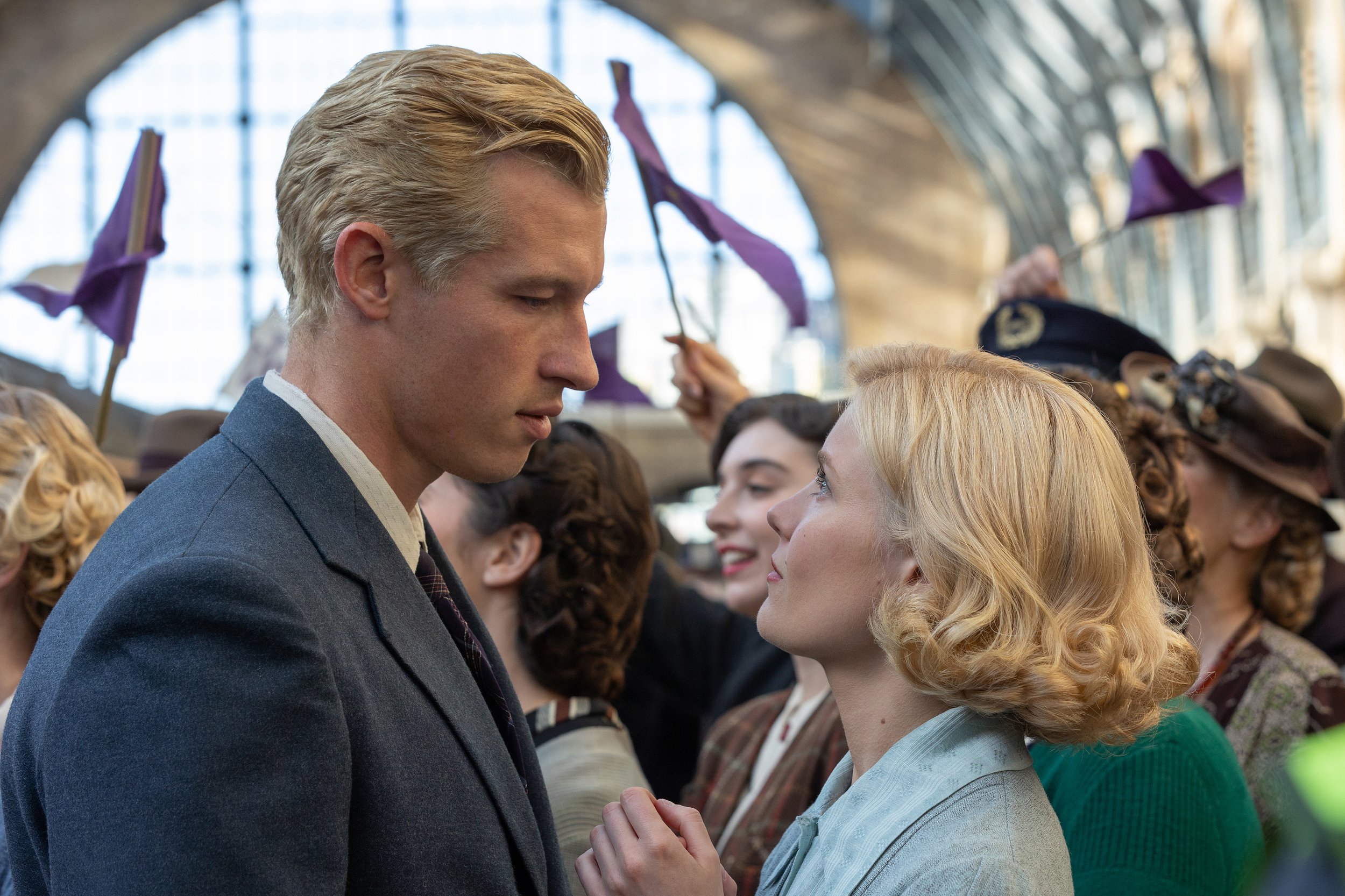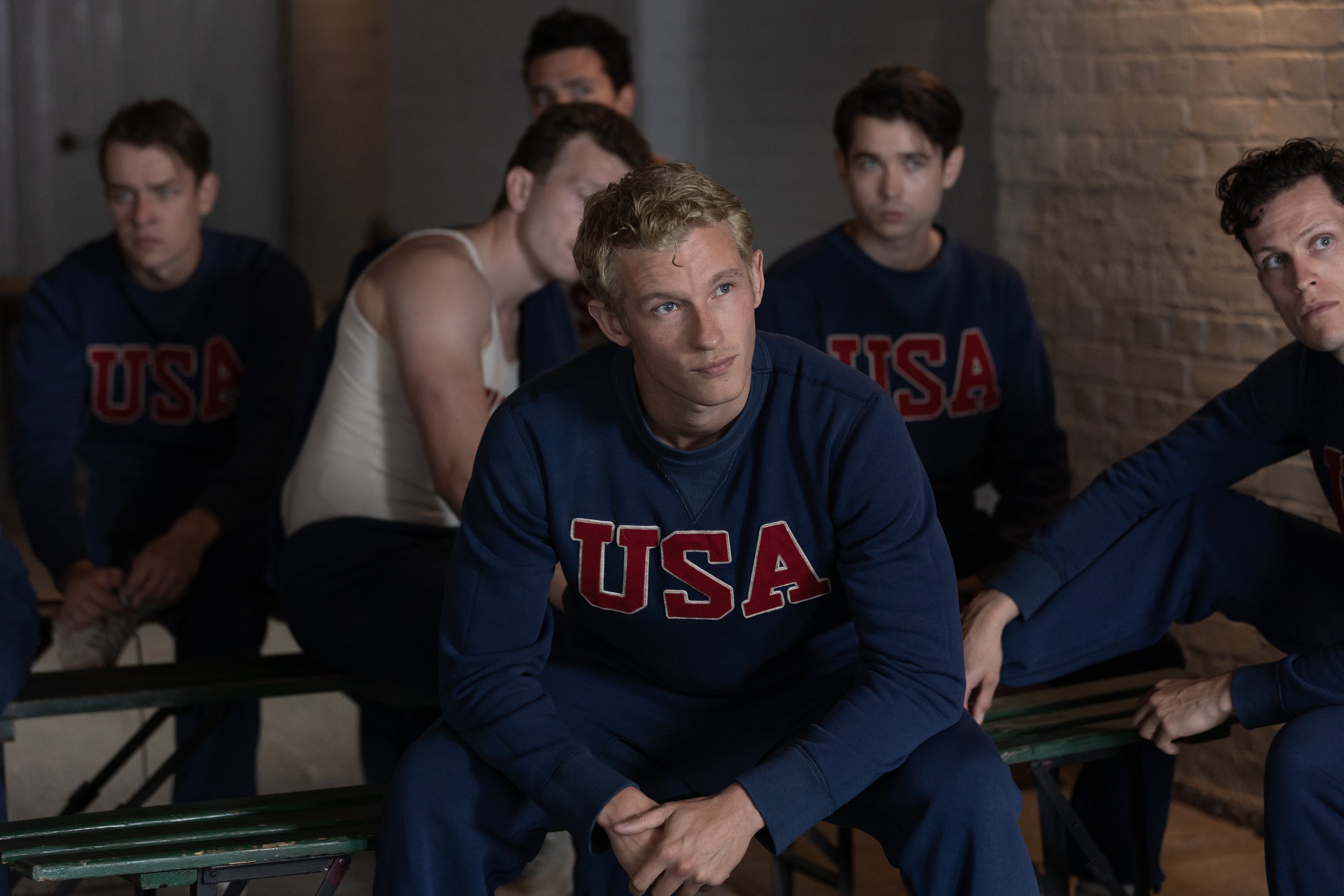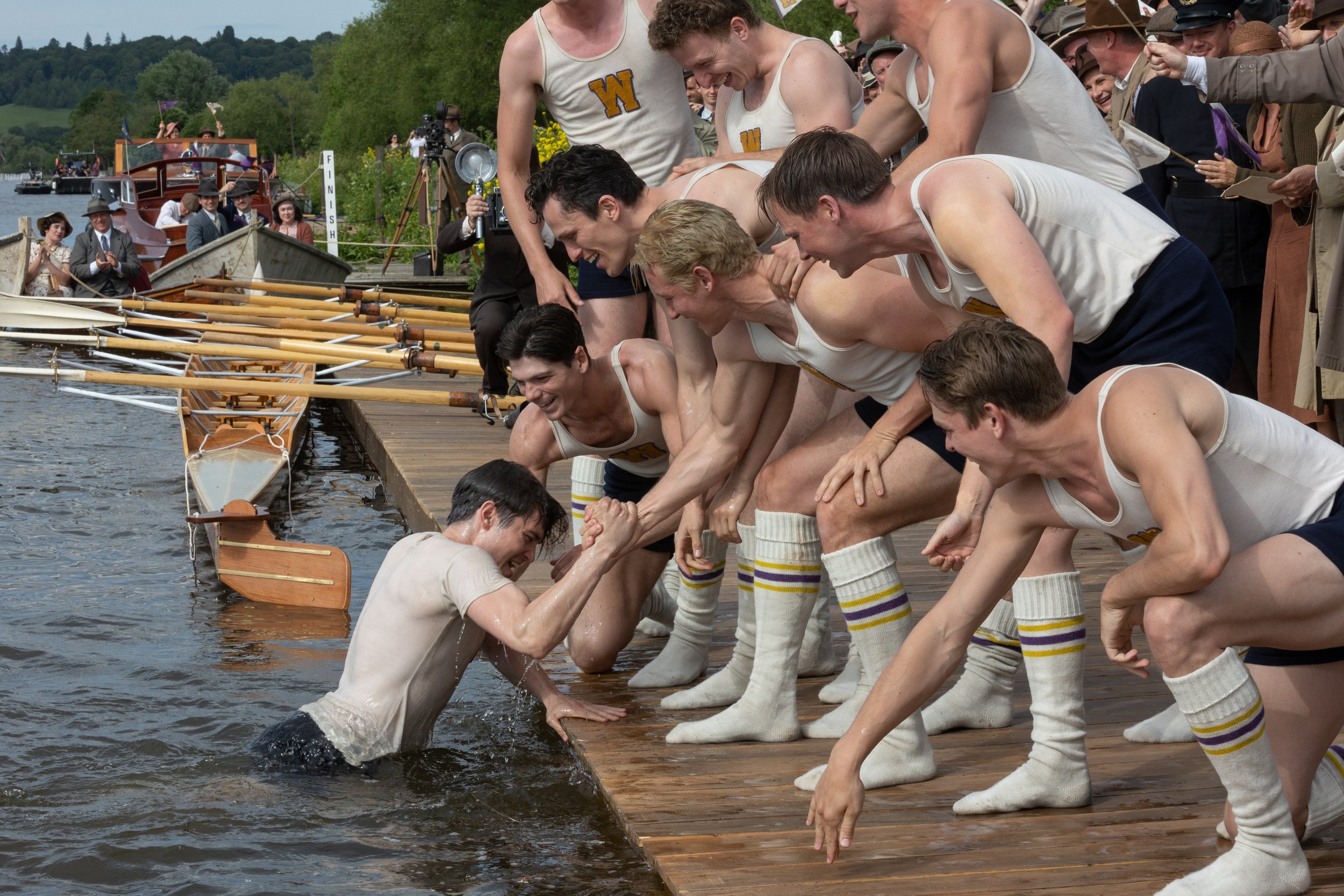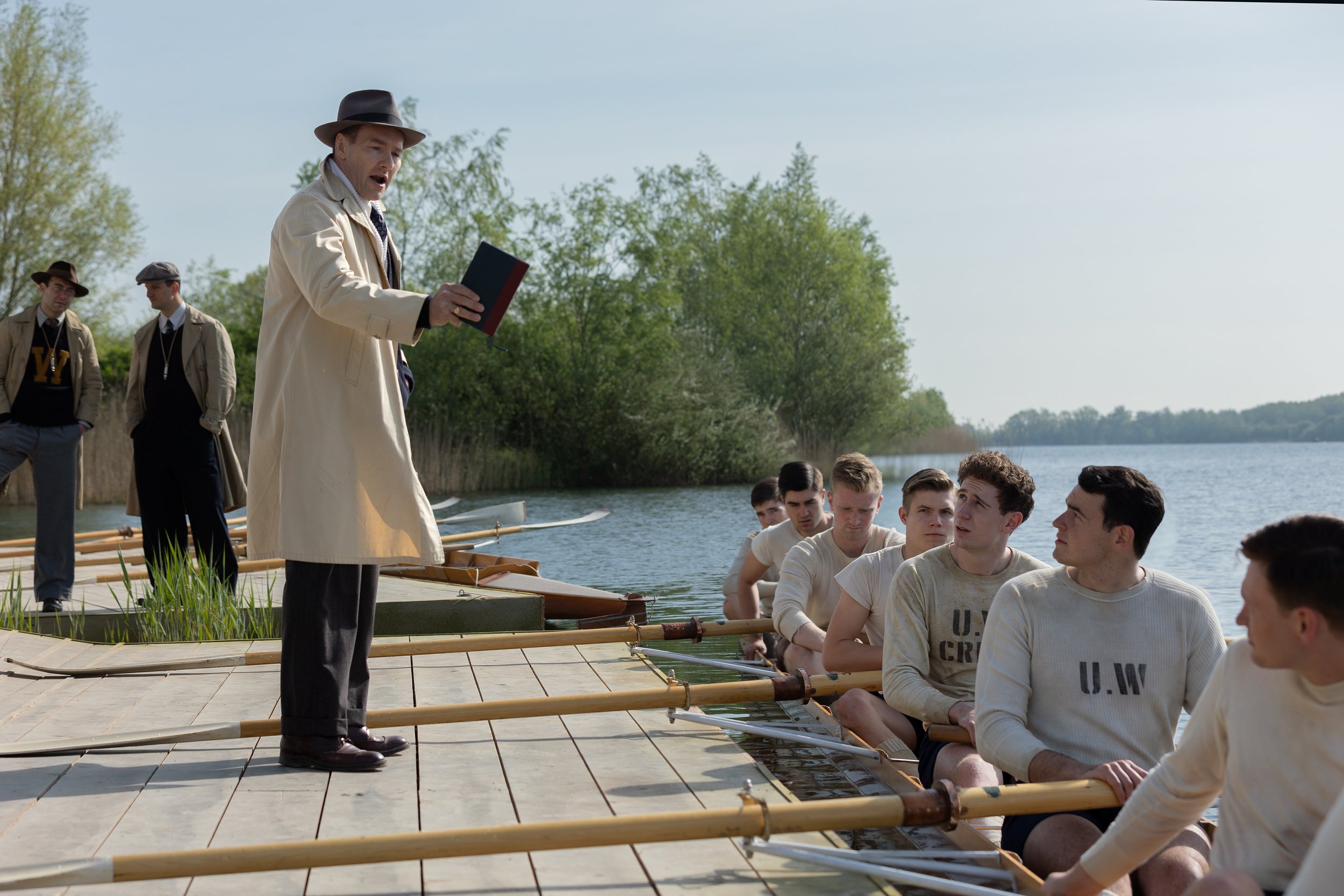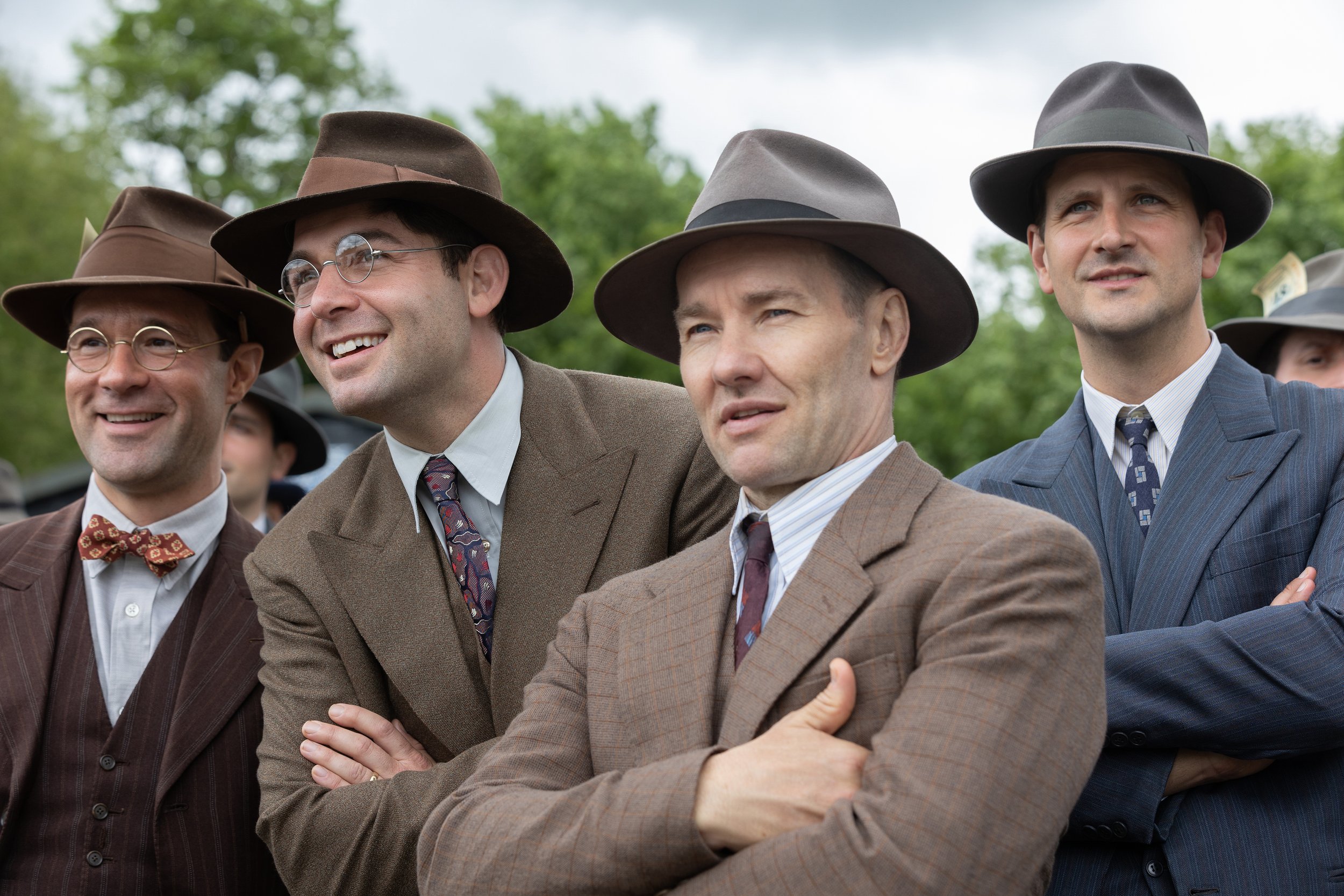MOVIE REVIEW: The Boys in the Boat
THE BOYS IN THE BOAT– 3 STARS
Look. We all know rowing isn’t exactly the most exciting sport under the sun today. Folks will hear “sculling” and “sweep” and think they’re hearing about Halloween janitorial services. Say “coxswain” to them and they’ll think you’re dropping a drunken Irish curse word. Regattas don’t appear on primetime TV coverage, and stores aren’t selling out jerseys of fans’ favorite vessels. I’m willing to bet the rowing machines collect the most dust at local gyms. Hell, for many moviegoers, the most legitimate rowing they’ve likely seen is probably a stock establishing shot or side-character action scene (like in The Social Network) of a rowing team on the water to signify to audiences the film’s setting is an Ivy League school where rowing is an elitist tradition of great repute.
LESSON #1: THE FORMER PROMINENCE OF ROWING– Now, turn back the clock nearly a century, and it’s a whole different story. Decades before the NFL, NBA, auto racing, and the advent of television, rowing carried a national radio following where the competitions drew millions of listeners and the champions became temporary public heroes. Granted, with those aforementioned and more proletariat sports eventually rising above them, the sport’s semi-snobbish notoriety, reeking of white privilege, was likely the top turnoff to keep rowing over with general audiences, and understandable so.
Nonetheless, that’s where The Boys in the Boat, the latest satiny period piece directed by George Clooney, hopes to rekindle old pride, honor, and excitement. Boosted by inspirational history and adapted from Daniel James Brown’s 2013 bestseller, Clooney’s film cannot push back the entire predominant stereotype described in Lesson #1, but it can offer a scrappy team of bourgeoisie to root for and showcase the dauntless fortitude to perform the marginalized sport itself.
The Boys and the Boat takes audiences to 1936 Seattle during the heart of the Great Depression. Plenty of impoverished families and wayward unemployed men found themselves in Hoovervilles waiting in charity lines for food, scrounging for basic living essentials, and chasing the few paying jobs that came their way. One of those Washington men was Joe Rantz (Callum Turner of the Fantastic Beasts series), living out of an old jalopy and pinching his pennies to maintain his tuition as an engineering student at the University of Washington.
Needing a steady paycheck, Joe and his close buddy Roger Morris (Sam Strike of When the Street Lights Go On) answer a recruiting call for the school’s rowing team under the authority of head coach Al Ulbrickson (the headlining Joel Edgerton), assistant coach Tom Bolles (veteran TV actor James Wolk), and old boat builder George Pocock (Alien 3’s Peter Guinness). Making their walk-on junior varsity eight squad would give the two of them greatly-improved boarding enough money to cover the cost of school. As they two soon find out, this isn’t a cute intramural college sport wearing sneakers in some gymnasium.
LESSON #2: THE GRUELING FINESSE OF ROWING– Coach Ulbrickson and his experienced coxswains– the non-rowing crew members in charge of steering and pushing the pacing cadence– led by Bobby Moch (Luke Slattery of New Amsterdam) put Joe, Roger, and dozens of other strapping men (including the fresh faces of Jack Mulhern, Thomas Elms, and Wil Coban) off the street through their paces to become legitimate athletes of power, stamina, and the grueling finesse of teamwork it takes to get maximum output from the united effort. Echoing the opening scenes of an old senior watching rowing in action years after the setting of The Boys in the Boat, there is power amid the serenity of seeing a top-flight boat cut through the water like a knife. Once again, it’s harder than it looks and arguably one of the most difficult and demanding Olympic team sports.
The Boys in the Boat puts respect on that effort of syncing and the bonded men who made it happen. Much like Jodie Foster in Nyad earlier this year, Joel Edgerton could have easily been stuck playing the same coach we’ve seen time and again blowing whistles, barking commands, and demanding discipline. Edgeron is given an arc and a rousing speech or two that softens the role’s innate hardness enough to appreciate. While there are admittedly too many separate people from a nine-man crew to flesh out fully and keep track of in a two-hour movie versus the full breadth a book can offer, the film sticks to Callum Turner’s broad shoulders and stoic appeal to be the dreamboat of choice with the lone romantic pairing (Hadley Robinson of Winning Time: The Rise of the Lakers Dynasty). Next to him, Luke Slattery and Jack Mulhern make solid impressions in the visible two positions on the boat in front of Turner’s Joe Rantz.
In another match from Nyad on Netflix, the challenges of shooting a movie on the water will always add a degree of difficulty for both economic completion and theatrical creativity. Luckily, The Boys in the Boat is simple enough and smaller in risky scale where George Clooney is not trying to sink the Titanic or put out Kevin Costner-level Waterworld hubris. Still, there are only so many ways to shoot the same straight-line races, cheering crowds, chanting coaches, and repetitive physical motions.
A brawnier director would overshoot The Boys in the Boat. Clooney and company set out to make a period film with a classical look of studio polish, meaning the in-your-face edginess possible from swooping drone photography, heavy greenscreen use, or mounted GoPro cameras hyper-edited into some kind of highlight reel mixtape would not fit aesthetically or tonally. With admirable credit, cinematographer Martin Ruhe and editor Tanya M. Swerling (who both worked with Clooney on The Tender Bar) took on that task and succeeded with a rhythm of clean clarity that did not sacrifice sports movie suspense. Viewers are taken inside plenty of the action and stirred nicely by a commanding score from two-time Oscar-winning composer Alexandre Desplat.
The rest of the timeline of The Boys in the Boat lined up as history played out. The junior varsity Washington team of rookie rowers defeated its own varsity squad of and those from California and the Ivy League at national regattas to become the team representing the U.S. at the 1936 Summer Olympic Games in Berlin, Germany– the very same which featured other semi-recent biopic subjects Jesse Owens (Race) and Louis Zamperini (Unbroken). The heroism of this team’s story is safe, clean enough for the high school social studies crowd for a movie day, and tailor-made for tugging heartstrings.
LESSON #3: SKIMPING ON HEFTY DEPTH– Lamentably, more depth was present and possible with The Boys in the Boat. Whether it was to tighten length or avoid controversial depictions, The Midnight Sky and upcoming Twisters screenwriter Mark L. Smith cut out one of two key backstory spines given expansive detail in the source novel. Author Daniel James Brown paralleled the growing camaraderie of the nine-member Washington JV team with the deception of Adolf Hitler’s Nazi regime using its dominant spectacle of grand Olympic pageantry to cover up their inhumane atrocities occurring elsewhere. In a time when addressing firebrands can separate the plain from the profound in both biopics and sports movies for today’s politics-craving audiences, this reduction can be seen as a missed opportunity.
The Boys in the Boat is far from the first hero worship movie for the departed Greatest Generation, but, by staying solely on their titular young men, the film lacks a sizable antagonistic presence or well-established moral opponent to make the eventual victory more impactful. It’s crazy to say that having nine men, a secondary university, and a regal sport beat the Great Depression and win a medal isn’t enough, but here we are measuring stakes. Yet, at the same time, a simplified focus on the celebratory positive is not the most egregious thing a filmmaker like George Clooney, or anyone else, can do. Softness isn’t all bad. If anything, there’s always a place in cinema for the optimistic tone and attitude to offer quaint, respectful, and uplifting fare like The Boys in the Boat, and that’s an earned win on its own.
LOGO DESIGNED BY MEENTS ILLUSTRATED (#1163)



